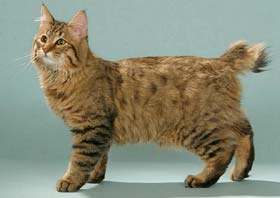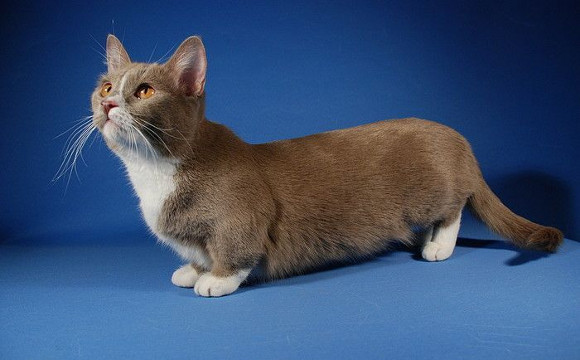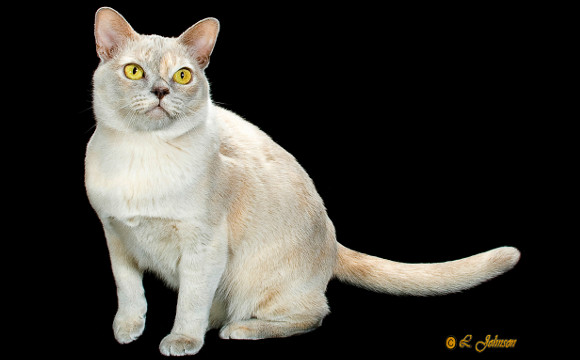History
The Cat-Book Poems, a manuscript of verses and paintings written sometime between 1350 and 1767 A.D. in Thailand, includes the earliest illustrations and descriptions of the Korat. The artists and writers of the document, whose names have long been forgotten, describe the Korat as a good luck cat, with eyes the color of new rice that shine like dewdrops on a lotus leaf, and a body the color of rain clouds and silver. Unlike Siamese cats that were primarily owned by Thailand’s royalty, Korats were the cats of the common people, and were highly prized as living good luck charms. Called Si-Sawat (si meaning color and sawat being the name of a fruit plant with a silver-blue seed), Korats were rarely sold, but rather were given as special expressions of respect and esteem. New brides were given a pair of Si-Sawat cats to ensure their happy marriages.
Whether the Cat-Book Poems was produced during the mid-fourteenth century or the mid-eighteenth makes little difference. Either way, the Korat can be deemed one of the oldest domestic cat breeds, along with its compatriots, the Siamese, Burmese, and Havana Brown, also described in the manuscript. The Korat is also considered one of today’s purest breeds; it looks very much like its wild ancestors that roamed the jungles of the Malay Peninsula.
Jean Johnson is credited with bringing the first Korat cats to America. Johnson, who lived in Bangkok with her husband for six years, tried unsuccessfully to buy a pair of Korats. In 1959 she was finally given a pair of Korats by the Thai government. The pair, Nara and Darra, became America’s foundation Korats. To avoid inbreeding, Johnson crossbred Nara and Darra to Siamese cats that she had also brought back from Thailand. She then carefully eliminated from her breeding program any kittens with Siamese characteristics. (Some researchers believe that the Korat returned the favor to the Siamese. The blue point is theorized to have originated from a cross between the seal point and the Korat, since there’s no actual record of the ancestry of the first blue points.)
In the 1960s more Korat cats were obtained from Thailand. In 1966 ACA became the first U.S. association to recognize the Korat, followed by the CFA later the same year. Today the Korat is recognized by all the U.S. registries and, while still rare, is being promoted by a growing and dedicated group of breeders and fanciers.
Today, in its native land, the Korat is hard to find and harder to export. In recent years numbers have dwindled and those that remain are prized by the Thai people, who still consider the cat a symbol of good luck. A recent anecdote tells of a Thai man who used his Korat’s cat show entry number when choosing numbers for a lottery ticket, and won.
Korat cats are not as vocal as their Siamese comrades; they have other ways of getting their wishes across. At dinnertime they’ll wrap themselves around your ankle, clamber up onto your shoulder, and perhaps give you a nip on the shin if you don’t hurry up with the cat food but given something important to say, they speak their minds.
On the cat activity level scale, they are an 8: social, playful, and full of life, but not bouncing-off-the-walls hyper. They are also reported to possess high intelligence.
Like the Siamese, Korat cats are fetchers of tossed toys, cats whose favorite game is the one in which you take an active part. Korat cats crave affection from their humans, and will scheme to gain possession of your lap, your arms, and your heart.
Coat and color, as well as a muscular and semi-cobby body type, set this breed apart. The coat is a solid, even, silver-blue color with no tabby markings or shading, but the hair shafts themselves are lighter at the roots and shade to a darker blue just before the tips. The fur is tipped with silver, giving a silvery sheen or “halo effect” to the coat. The Korat goes through an “ugly duckling” phase and doesn’t attain its true beauty until two to four years of age. The eye color is not usually true until the cat matures.
- ☆☆☆☆☆☆☆☆ Activity
- ☆☆☆☆☆☆☆☆ Playfulness
- ☆☆☆☆☆☆☆☆ Need for Attention
- ☆☆☆☆☆☆☆☆☆ Affection
- ☆☆☆☆☆ Need to Vocalize
- ☆ Docility
- ☆☆☆☆☆☆☆☆ Intelligence
- ☆☆☆ Independence
- ☆☆☆ Healthiness and Hardiness
- ☆☆ Grooming needs
- ☆☆☆☆☆ Good with children
- ☆☆☆☆☆ Good with other pets













